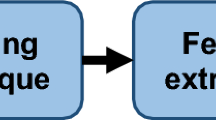Abstract
Detecting Singing segments in a segment of a soundtrack is an important and useful technique in musical signal processing and retrieval. In this paper, we study the accuracy of detecting singing segments using the HMM (Hidden Markov Model) classifier with various features, including MFCC (Mel Frequency Cepstral Coefficients), LPCC (Linear Predictive Cepstral Coefficients), and LPC (Linear Prediction Coefficients). Simulation results show that detecting singing segments in a soundtrack is more difficult than detecting them among pure-instrument segments. In addition, combining MFCC and LPCC yield higher accuracy. The bootstrapping technique has only limited accuracy improvement to detect all singing segments in a soundtrack. To be complete, we also conduct an experiment to show that the time to perform music identification can be reduced by more than 40 % if we incorporate the singing-voice detection mechanism into the identification process.





Similar content being viewed by others
References
Becchetti C, Ricotti LP (1999) Speech recognition: theory and C++ implementation. Wiley, New York
Berenzweig AL, Ellis DPW (2001) “Locating singing voice segments within music signals.” IEEE Workshop on Applications of Signal Processing to Audio and Acoustics, 21–24
Cano P, Battle E, Kalker T, Haitsma J (2005) A review of audio fingerprinting. J VLSI Signal Process 41(3):271–284
Casey MA (1987) “MPEG-7 sound recognition tools,” IEEE Trans. Circuits and Systems for Video Tech, vol. 11, no. 6, pp. 737–747, June, 2001.D. O’Shaughnessy, Speech Communication: Human and Machine, Addison-Wesley, Reading MA
Casey MA (2001) “Reduced-rank spectra and minimum-entropy priors as consistent and reliable cues for generalized sound recognition.” Proceedings of workshop for consistent & reliable acoustic cues for sound analysis. Columbia Univ., NY, USA, 167
Cho H, Choi M (2014) Personal mobile album/diary application development. J Converg 5(1):32–37
http://www.siliconrepublic.com/digital-life/item/38714-15-billion-songs-have-been
ISO/IEC (2002) Information Technology -- Multimedia Content Description Interface -Part 4: Audio, IS 15938–4
ISO/IEC (2003) Information technology -- Multimedia content description interface -- Part 6: Reference software ISO 15938–6. The reference program is available at http://standards.iso.org/ittf/PubliclyAvailableStandards/c035364_ISO_IEC_15938-6%28E%29_Reference_Software.zip
Lindsay PH, Norman DA (1977) Human information processing: An introduction to psychology, 2nd edn. Academic, New York
Lukashevich H, H. et al (2007) “Effective singing voice detection in popular music using ARMA filtering.” Proc. 10th International Conference on Digital Audio Effects (DAFx-07), Bordeaux, France, 10–15
Murrphy K (19998) “Hidden Markov Model (HMM) Toolbox for Matlab,” available at http://www.cs.ubc.ca/~murphyk/Software/HMM/hmm.html
New TL et al (2004) “Singing voice detection in popular music.” Proc. 12th Annual ACM International Conference on Multimedia, 1–4
O’Shaughnessy D (1987) Speech communication: Human and machine. Addison-Wesley, Reading
Rabiner LR, Juang BH (1993) Fundamentals of speech recognition. Prentice Hall, Englewood Cliffs
Rocamora M, Herrera P (2007) “Comparing audio descriptors for singing voice detection in music audio files.” Proc. of 11th Brazilian Symposium on Computer Music, 1–10
Tzanetakis G (2004) “Song-specific bootstrapping of singing voice structure.” Proc. 2004 I.E. International Conference on Multimedia and Expo, vol. 3, 2027–2030
Vembu S, Baumann S (2005) “Separation of vocals from polyphonic audio recordings.” Proc. of 6th International Conference on Music Information Retrieval (ISMIR 2005), 1–8
Yoon S-H, Min J (2013) An intelligent automatic early detection system of forest fire smoke signatures using gaussian mixture model. J Inf Process Syst 9(4):621–632
You SD, Pu Y-H (2015) Using paired distances of signal peaks in stereo channels as fingerprints for copy identification. ACM Trans Multimedia Comput Commun Appl 12(1):22
You SD, Chen W-H (2015) Comparative study of methods for reducing dimensionality of MPEG-7 audio signature descriptors. Multimed Tools Appl 74(10):3579–3598
You SD, Chen W-H, Chen W-K (2013) “Music identification system using MPEG-7 audio signature descriptors.” Sci World J 2013:doi:10.1155/2013/752464
Acknowledgments
This work was supported in part by National Science Council (NSC) and Ministry of Science and Technology (MOST) of Taiwan through Grants NSC 101-2221-E-027-127 and MOST 103-2221-E-027-092.
Author information
Authors and Affiliations
Corresponding author
Rights and permissions
About this article
Cite this article
You, S.D., Wu, YC. & Peng, SH. Comparative study of singing voice detection methods. Multimed Tools Appl 75, 15509–15524 (2016). https://doi.org/10.1007/s11042-015-2894-9
Received:
Revised:
Accepted:
Published:
Issue Date:
DOI: https://doi.org/10.1007/s11042-015-2894-9




